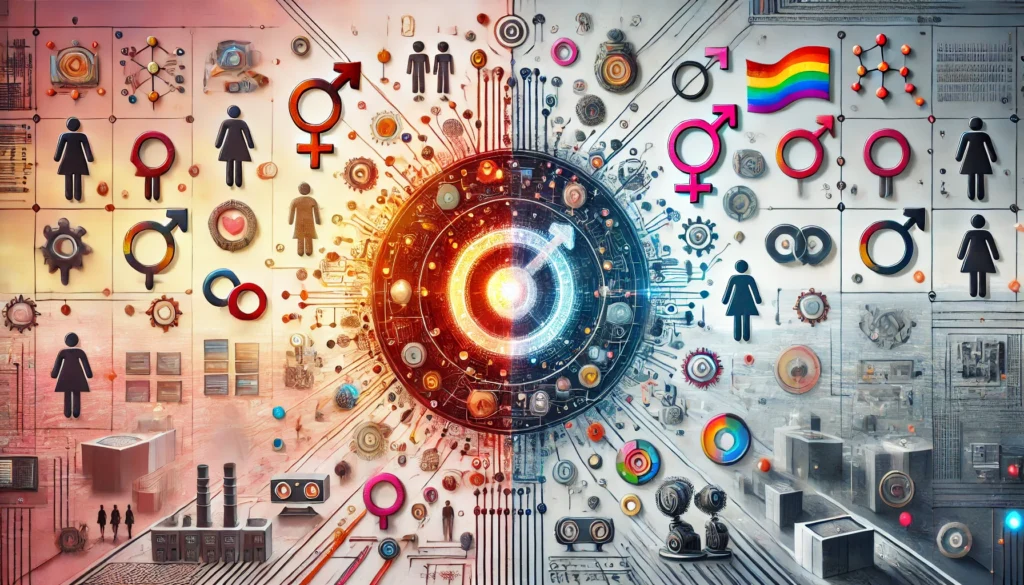
Interim CIO: Dr. Claus Michael Sattler
Gendering and digitization
What does the discussion about gender and queer lifestyles have to do with digitalization and artificial intelligence?

As an interested citizen who often finds discussions about gender superfluous in the face of the pressing technological and economic challenges of our time, I would like to take a sober look at the link between gender issues and digital transformation.
In recent years, an intense debate has developed around gender and digitalization, which may seem far-fetched at first glance. However, a closer look reveals that these topics are actually more closely intertwined than one might initially think.
Artificial intelligence and gender bias
A central aspect of the discussion revolves around the question of the extent to which artificial intelligence (AI) reproduces or even reinforces existing gender inequalities. Studies indicate that men perceive artificial intelligence applications more positively than women and rate their skills in this area more highly [source: 1]. These differences in perception could lead to women remaining underrepresented in the development and application of artificial intelligence technologies.
Critics argue that the vast majority of AI developers are male, white and young, which can lead to a biased perspective in the design of AI systems [source: 2]. This lack of diversity could result in unintended biases in AI algorithms that reinforce existing social inequalities.
Automation and gender roles
Another aspect of the gender and digitalization debate concerns the impact of automation on occupational fields traditionally dominated by women. It is feared that certain jobs that are often performed by women could be replaced by artificial intelligence, which could lead to a worsening of gender inequality in the labor market [source: 2].
On the other hand, digitalization also offers opportunities to redesign work processes and cultures. Flexible working models and digital collaboration tools could break down traditional gender roles and enable a better work-life balance.
Artificial intelligence as a tool for promoting equality
Interestingly, artificial intelligence is not only being discussed as a potential problem, but also as a possible solution to gender inequality. Some researchers and developers are working on creating artificial intelligence systems that can actively contribute to the promotion of diversity and equality [source: 3].
For example, artificial intelligence-supported analysis tools could help to uncover and reduce unconscious bias in recruitment processes or promotion decisions. Efforts are also being made in the field of language processing to promote gender-neutral or gender-inclusive formulations.
The role of ethics and regulation
The discussion about gender and digitalization also has an important ethical and regulatory dimension. There are increasing calls to consider ethical guidelines that explicitly address gender equality and diversity in the development and implementation of artificial intelligence systems [source: 4].
Political decision-makers face the challenge of creating a regulatory framework that promotes innovation on the one hand and minimizes the potential negative impact of artificial intelligence on certain population groups on the other.
Critical view of the debate
As an interested citizen with an eye on the technological and economic challenges of our time, I cannot help but critically question the sometimes excessive focus on gender issues in the artificial intelligence debate.
While it is undoubtedly important to address potential discrimination through artificial intelligence systems, there is a danger that we will get lost in ideological discussions and lose sight of the actual opportunities and risks of digitalization.
In my opinion, the competitiveness of our economy, the creation of sustainable jobs and tackling global challenges such as climate change should be a priority. The gender debate in the context of digitalization must not lead to us getting lost in the details and losing sight of the big picture.
Outlook and recommendations for action
Despite my critical attitude towards an overemphasis on gender issues in the digitization debate, some sensible recommendations for action can be derived:
- Promoting diversity in STEM subjects: In order to achieve a more balanced representation in AI development in the long term, we should increasingly encourage women and other underrepresented groups to pursue STEM subjects.
- Raising awareness of artificial intelligence biases: Developers and users of artificial intelligence systems should be sensitized to possible biases in order to identify and address them at an early stage.
- Ethical guidelines for artificial intelligence development: The development and implementation of ethical guidelines for artificial intelligence development that take into account aspects of gender equality and diversity without hindering technological innovation.
- Focus on economic opportunities: Despite all the consideration of gender issues, we must not forget that digitalization and artificial intelligence offer enormous economic opportunities that we must exploit in global competition.
- Pragmatic approach: Instead of getting lost in ideological debates, we should pursue a pragmatic approach that makes the benefits of digitalization available to all population groups without favoring or disadvantaging certain groups.
Conclusion
The discussion about gender and digitalization is undoubtedly complex and multi-layered. While it is important to address potential inequalities and discrimination through artificial intelligence systems, we must not lose sight of the overarching goals of digital transformation.
As an interested citizen, I advocate a balanced approach that makes the opportunities of digitalization and artificial intelligence accessible to all population groups without getting lost in exaggerated gender debates. Ultimately, it is about developing and using innovative technologies that strengthen our economy, create jobs and help solve pressing social problems – regardless of gender, origin or other characteristics.
The challenges of the future require our full attention and energy. Let us therefore focus on the key aspects of digitalization and work together on solutions that benefit everyone. This is the only way we can really take advantage of the opportunities presented by the digital transformation and at the same time shape a fair and inclusive society.
Sources
- https://digid.jff.de/digid_paper/gender-und-Künstliche intelligence-applications-traegt-artificial-intelligence-for-the-gender-problem-or-its-solution-at/
- https://www.wsi.de/data/wsimit_2024_01_carstensen.pdf
- https://www.uni-hildesheim.de/zentrum-fuer-geschlechterforschung/gender-werkstatt/workshops-vortraege/details/diversitaetssensible-informatik/
- https://www.bmz-digital.global/biases-und-Künstliche intelligence-how-neutral-is-technology/
- https://www.boeckler.de/fpdf/HBS-008607/p_fofoe_WP_274_2023.pdf
- https://www.oeaw.ac.at/detail/news/gender-bias-in-der-technologieentwicklung
- Image: ChatGPT